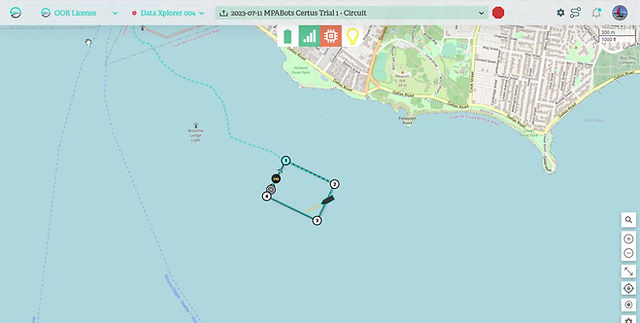
SECURE
REAL-TIME
MADE FOR BIG DATA
MEET XPLORERVIEW™
XplorerView™ is our secure cloud-based portal for real-time data viewing, actionable insights, and USV operations. Its easy-to-use interface enables stakeholders to access USV-collected data instantly and analyze it with supplemental data feeds, including Enhanced Horizon’s AI-powered situational awareness and Underwater Listener’s advanced acoustic intelligence, maximizing its value.
For USV operators, XplorerView™ provides a comprehensive command and control system to optimize USV operations. With real-time wind, current, and traffic data, alongside tools to enhance vessel performance, we offer operators an intuitive and powerful platform for managing and monitoring their missions.
XplorerView™ also supports secure data sharing, delivering USV-collected data, AI-driven insights from Enhanced Horizon, and underwater acoustic analytics from Underwater Listener directly to your operating system.


SECURE MULTI-USER SYSTEM
XplorerView™ is designed for secure data viewing and sharing. With customizable user configurations, you can choose what to share with stakeholders, powering collaborative relationships and optimizing information delivery.
REAL-TIME DATA VISUALIZATION
XplorerView™ is your portal to view and manage real-time USV acquired data. Supplemented with additional key datasets including weather, vessel traffic, and oceanographic parameters, it provides comprehensive tools for informed decision making.
AI-DRIVEN ANALYTICS
XplorerView™ uses custom AI analytics to deliver key insights on acquired data. This provides better detections of vessels, animals, and other objects, as well as improved data collection. Paired with DataXplorer’s AI powered edge computing system, it maximizes the value of acquired data to provide with an unparalleled understanding of key ocean parameters.
XPLORERVIEW™
XplorerView™ is an advanced command & control system designed to optimize the performance of our solar-powered USVs. Speed, heading, and loiter radius are precisely controlled with easy-to-use tools, and multiple USVs can be operated simultaneously. Key actions can be planned and programmed for specific waypoints, including image capture, loiter, and sensor activation/deactivation.
It simplifies mission preparation with drag and drop waypoints, distance calculations, and grid survey tools. Mission parameters can also be imported, while past missions are stored in the mission library, where they can be viewed, copied, and updated for reuse.

REAL-TIME PERFORMANCE MONITORING
Real-time monitoring of system health, weather conditions, and data quality ensure optimal mission execution and data acquisition. USV operators are kept aware of key events with alerts that deliver information needed for informed decision making.
COMPREHENSIVE NAVIGATIONAL TOOLS
Navigation is simplified with a range of overlays that provide nautical navigation charts, bathymetric charts, satellite imagery, AIS, and tide tables.
PRECISION CONTROL
USV speed and direction can be tightly controlled and monitored. Missions can be pre-programmed for autonomous execution and modified as needed in real-time. The operator can also enter manual mode to control the USV directly.
POWER
MANAGEMENT
Designed to maximize the performance of solar powered USVs, XplorerView™’s intuitive platform provides power management tools to extend mission duration and optimize data collection. This includes detailed power usage and capture analytics, battery levels, solar input, and remaining mission time. Operators also can switch into low power mode and turn on or off sensors as needed.
MISSION
REPLAY
Mission telemetry and system health data, including cumulative time on water, motor running time, and battery analytics are recorded from each mission for future analysis. Collected oceanographic and environmental data is also logged and available for replay.
AI AUGMENTED NAVIGATION
XplorerView™ displays USV collected maritime situational awareness data including AIS, camera feeds, radar, and depth, along with AI-driven analytics for safe navigation. Potential obstacles and collision threats are displayed along with critical data including the closest point of approach (CPA) and estimated time to arrival. Alerts can also be sent to the remote operator for timely action.
Underwater Listener™
Underwater Listener™ leverages AI-driven acoustic detection and classification to identify and analyze sounds from sources on and below the surface. From ship engines and marine mammals to machinery like winches, this innovative system provides real-time insights into underwater activity.

Enhanced Horizon™
Enhanced Horizon™ is our camera-driven detection and identification system designed to provide unparalleled situational awareness. Leveraging advanced AI technology, it detects and identifies a wide range of objects, from ships to marine life, far beyond the range of human sight.
Enhanced Horizon™ has detected vessels over 9 nautical miles away, well before AIS detection, demonstrating its ability to deliver critical insights in real-time.
